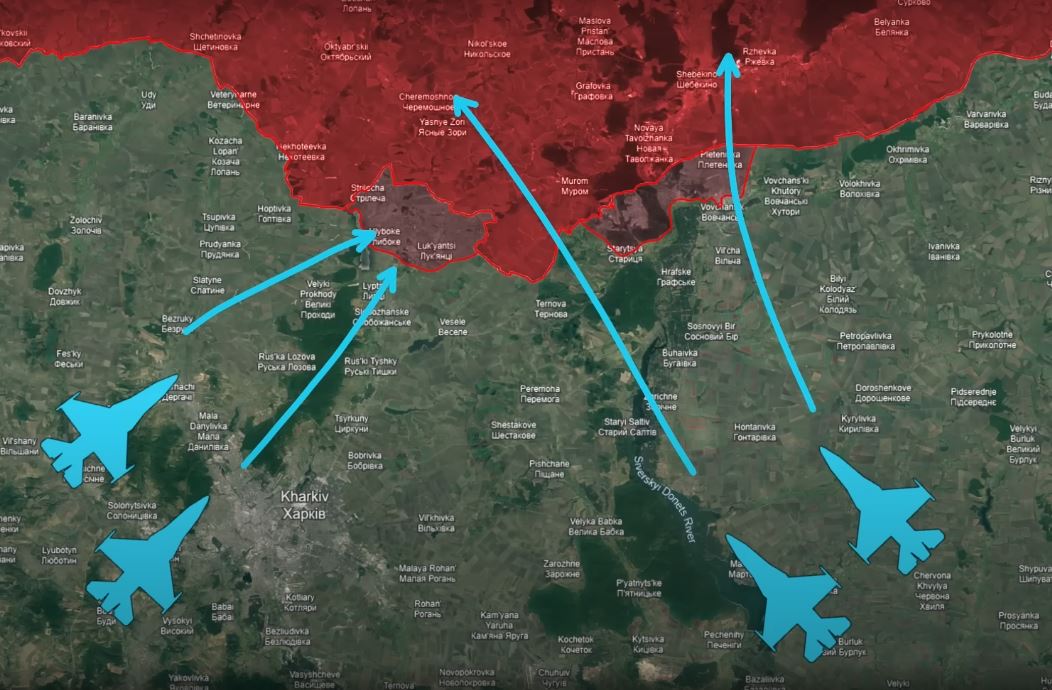9 July. Today, there are a lot of updates from the Lyptsi direction, Kharkiv Oblast.

Here, Ukrainians unleashed massive air strikes with guided bombs, both on Russian frontline targets and the Russian rear.

Russians, losing their grip on Hlyboke, attempted a desperate mechanized assault on Ukrainians as Ukrainians advanced into the settlement.

While Ukrainians have little measures to defend against extensive Russian glide bomb strikes, the United States has provided Ukraine with western GBU-39 guided glide bombs to be able to hit back at Russian forces.

The GBU-39 is a conventional bomb equipped with wings that extend the range of the bombs to a maximum of 110 kilometers by allowing them to glide through the air. These wings are also programmable with GPS coordinates and laser guidance kits for precision strikes and circumventing Russian GPS jamming. Finally, these bombs were also delivered with specialized bomb racks that fit multiple bombs under one hardpoint, meaning Ukrainians can strike numerous targets at once.
However, Ukraine is not currently being provided with enough of these bombs to be able to launch constant strikes on the Russian military. Brigadier General Serhii Holubtsov said in an interview that to compensate, Ukraine is pursuing a domestic production of these bombs, noting that a Ukrainian variant is currently being developed and is being tested.
The United States and France have also, for a while now, supplied the Ukrainian air force with JDAM and AASM “Hammer” guided bombs, which Ukrainians have been using to strike Russian targets all over the front.

Recently released geolocated footage shows a Ukrainian Mig-29 dropping two French AASM “Hammer” guided bombs on a Russian command post on the international border.

The Institute for the Study of War noted that due to the close proximity to the Kharkiv front, this command post was likely involved in overseeing and coordinating Russian offensive and defensive efforts in this direction.
Ukrainians also continued to monitor and drop more “Hammer” guided bombs on Russian positions in Hlyboke. Geolocated footage shows Russians moving into the buildings in the settlement before being destroyed by a Ukrainian air strike.

Another video shows Ukrainians repeatedly hitting a Russian building with guided bombs till it fully collapsed. The original uncensored footage of all Ukrainian airstrikes can be found on our Telegram channel through the link in the description.
Ukrainians also conducted a series of long-range strikes on the Kursk and Voronezh regions in Russia.

In Kursk, a Russian military base was destroyed, which Russians used to reinforce their ongoing operations in northern Ukraine. While in Voronezh, Ukrainians struck another Russian ammunition warehouse and judging by the size of the rising smoke clouds; it was a big one, and Ukrainians had destroyed many shells and equipment.

Madyar’s Birds drone detachment also released an 18-minute video detailing their logistical strikes on the Russian supply lines. They reveal they had extensively mined Russian roads with drones and held them under FPV-fire control, destroying vast amounts of Russian reinforcements, supply trucks, and even some armored vehicles. One short clip even shows how, on just one road, Ukrainians had destroyed over 18 Russian vehicles carrying infantry, ammunition, and other supplies.

Ukrainian soldiers note that because of the threat posed by Ukrainian mines and drones, Russians started avoiding the roads in favor of moving through forests and other green terrain.

Unfortunately for Russians, Ukrainians then promptly started mining the forests and tree lines, to great effect. As Ukrainian sappers in the area state, they can constantly hear these mines exploding throughout the day and night as Russians are moving toward and in between positions.
The combined and continued effort of striking Russian frontline and rear positions and severe damage to Russian logistics put Ukrainians in an advantageous position to attack.

Geolocated footage released by Russian units reveals that Ukrainians had launched a spearhead attack into Hlyboke. Ukrainians broke through along the tree line, taking control over the river crossing and quickly enveloping the settlement to cut off Russian reinforcements.

Russian commanders realized that they were losing their grip on Hlyboke and ordered a desperate mechanized assault to push Ukrainians back out of the town despite the high risk of losing their armored vehicles. Russians launched an attack consisting of five turtle tanks mounting infantry on top as further reinforcements.

Ukrainians opened fire on the Russian assault with artillery, destroying three of the turtle tanks as well as a platoon worth of infantry with cluster munitions before they even came close to the settlement. Realizing the breakout attempt had failed and not wanting to meet the same fate, the last two turtle tanks retreated back to the international border along with any infantry that survived the artillery bombardment.

The uncensored footage of all ground operations can be found on Reporting From Ukraine’s Telegram channel. Overall, Ukrainian forces effectively used advanced Western munitions, distant mining, and drone strikes to disrupt Russian logistics.

This weakened Russian combat capabilities and allowed Ukrainians to establish a foothold in Hlyboke, repelling a desperate mechanized assault in the process. This underscores Ukrainian ability to create and capitalize on weaknesses in the Russian defense. Ukrainians will also be able to continue these effective strikes as domestic production of glide bombs comes online.
In our daily frontline report, we pair up with the military blogger Reporting from Ukraine to keep you informed about what is happening on the battlefield in the Russo-Ukrainian war.



